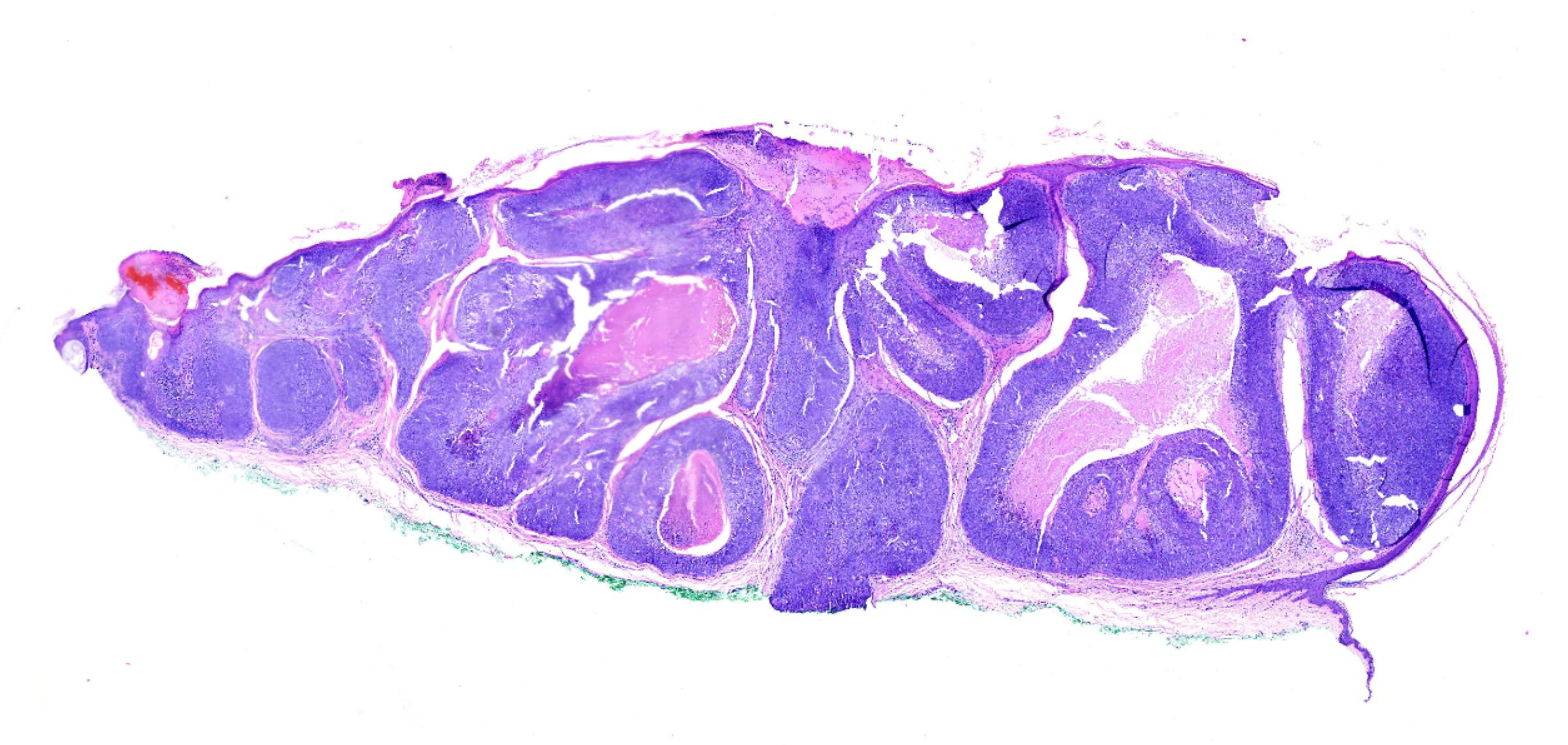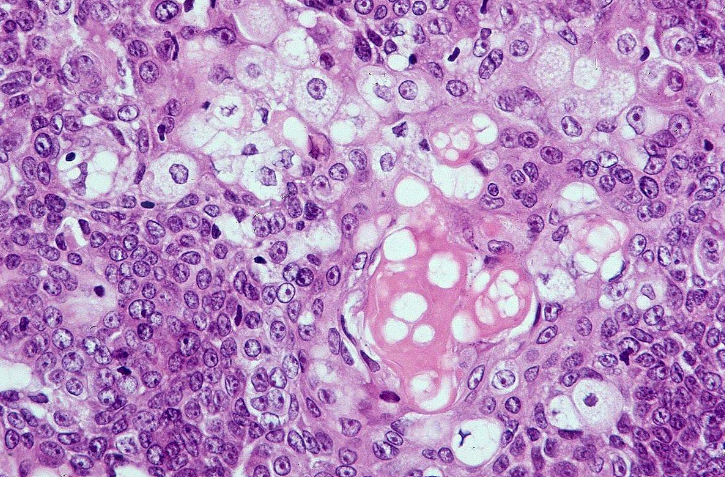[1]
Dasgupta T, Wilson LD, Yu JB. A retrospective review of 1349 cases of sebaceous carcinoma. Cancer. 2009 Jan 1:115(1):158-65. doi: 10.1002/cncr.23952. Epub
[PubMed PMID: 18988294]
Level 2 (mid-level) evidence
[2]
Salazar-Villegas Á, Matas J, Palma-Carvajal F, González-Valdivia H, Alos L, Ortiz-Pérez S. Sebaceous carcinoma of the caruncle. Journal francais d'ophtalmologie. 2019 Oct:42(8):925-927. doi: 10.1016/j.jfo.2019.04.014. Epub 2019 Jun 6
[PubMed PMID: 31178073]
[3]
Kraft S, Granter SR. Molecular pathology of skin neoplasms of the head and neck. Archives of pathology & laboratory medicine. 2014 Jun:138(6):759-87. doi: 10.5858/arpa.2013-0157-RA. Epub
[PubMed PMID: 24878016]
[4]
Rajan Kd A, Burris C, Iliff N, Grant M, Eshleman JR, Eberhart CG. DNA mismatch repair defects and microsatellite instability status in periocular sebaceous carcinoma. American journal of ophthalmology. 2014 Mar:157(3):640-7.e1-2. doi: 10.1016/j.ajo.2013.12.002. Epub 2013 Dec 7
[PubMed PMID: 24321472]
[5]
Kuzel P, Metelitsa AI, Dover DC, Salopek TG. Epidemiology of sebaceous carcinoma in Alberta, Canada, from 1988 to 2007. Journal of cutaneous medicine and surgery. 2012 Nov-Dec:16(6):417-23
[PubMed PMID: 23149197]
[6]
Dores GM, Curtis RE, Toro JR, Devesa SS, Fraumeni JF Jr. Incidence of cutaneous sebaceous carcinoma and risk of associated neoplasms: insight into Muir-Torre syndrome. Cancer. 2008 Dec 15:113(12):3372-81. doi: 10.1002/cncr.23963. Epub
[PubMed PMID: 18932259]
[7]
Tripathi R, Chen Z, Li L, Bordeaux JS. Incidence and survival of sebaceous carcinoma in the United States. Journal of the American Academy of Dermatology. 2016 Dec:75(6):1210-1215. doi: 10.1016/j.jaad.2016.07.046. Epub 2016 Oct 6
[PubMed PMID: 27720512]
[8]
Omura NE, Collison DW, Perry AE, Myers LM. Sebaceous carcinoma in children. Journal of the American Academy of Dermatology. 2002 Dec:47(6):950-3
[PubMed PMID: 12451386]
[9]
Rao NA, Hidayat AA, McLean IW, Zimmerman LE. Sebaceous carcinomas of the ocular adnexa: A clinicopathologic study of 104 cases, with five-year follow-up data. Human pathology. 1982 Feb:13(2):113-22
[PubMed PMID: 7076199]
Level 3 (low-level) evidence
[10]
Nelson BR, Hamlet KR, Gillard M, Railan D, Johnson TM. Sebaceous carcinoma. Journal of the American Academy of Dermatology. 1995 Jul:33(1):1-15; quiz 16-8
[PubMed PMID: 7601925]
[11]
Jakobiec FA, Mendoza PR. Eyelid sebaceous carcinoma: clinicopathologic and multiparametric immunohistochemical analysis that includes adipophilin. American journal of ophthalmology. 2014 Jan:157(1):186-208.e2. doi: 10.1016/j.ajo.2013.08.015. Epub 2013 Oct 7
[PubMed PMID: 24112633]
[12]
Mulay K, White VA, Shah SJ, Honavar SG. Sebaceous carcinoma: clinicopathologic features and diagnostic role of immunohistochemistry (including androgen receptor). Canadian journal of ophthalmology. Journal canadien d'ophtalmologie. 2014 Aug:49(4):326-32. doi: 10.1016/j.jcjo.2014.04.004. Epub 2014 Jul 19
[PubMed PMID: 25103648]
[13]
Uhlenhake EE, Clark LN, Smoller BR, Shalin SC, Gardner JM. Nuclear factor XIIIa staining (clone AC-1A1 mouse monoclonal) is a sensitive and specific marker to discriminate sebaceous proliferations from other cutaneous clear cell neoplasms. Journal of cutaneous pathology. 2016 Aug:43(8):649-56. doi: 10.1111/cup.12726. Epub 2016 Jun 10
[PubMed PMID: 27153339]
[14]
Ansai S, Takeichi H, Arase S, Kawana S, Kimura T. Sebaceous carcinoma: an immunohistochemical reappraisal. The American Journal of dermatopathology. 2011 Aug:33(6):579-87. doi: 10.1097/DAD.0b013e31820a2027. Epub
[PubMed PMID: 21778832]
[15]
Ostler DA, Prieto VG, Reed JA, Deavers MT, Lazar AJ, Ivan D. Adipophilin expression in sebaceous tumors and other cutaneous lesions with clear cell histology: an immunohistochemical study of 117 cases. Modern pathology : an official journal of the United States and Canadian Academy of Pathology, Inc. 2010 Apr:23(4):567-73. doi: 10.1038/modpathol.2010.1. Epub 2010 Jan 29
[PubMed PMID: 20118912]
Level 3 (low-level) evidence
[16]
Gnepp DR. My journey into the world of salivary gland sebaceous neoplasms. Head and neck pathology. 2012 Mar:6(1):101-10. doi: 10.1007/s12105-012-0343-x. Epub 2012 Mar 20
[PubMed PMID: 22430772]
[17]
Plaza JA, Mackinnon A, Carrillo L, Prieto VG, Sangueza M, Suster S. Role of immunohistochemistry in the diagnosis of sebaceous carcinoma: a clinicopathologic and immunohistochemical study. The American Journal of dermatopathology. 2015 Nov:37(11):809-21. doi: 10.1097/DAD.0000000000000255. Epub
[PubMed PMID: 26485238]
[18]
Hou JL, Killian JM, Baum CL, Otley CC, Roenigk RK, Arpey CJ, Weaver AL, Brewer JD. Characteristics of sebaceous carcinoma and early outcomes of treatment using Mohs micrographic surgery versus wide local excision: an update of the Mayo Clinic experience over the past 2 decades. Dermatologic surgery : official publication for American Society for Dermatologic Surgery [et al.]. 2014 Mar:40(3):241-6. doi: 10.1111/dsu.12433. Epub 2014 Jan 25
[PubMed PMID: 24460730]
[19]
Shields JA, Demirci H, Marr BP, Eagle RC Jr, Stefanyszyn M, Shields CL. Conjunctival epithelial involvement by eyelid sebaceous carcinoma. The 2003 J. Howard Stokes lecture. Ophthalmic plastic and reconstructive surgery. 2005 Mar:21(2):92-6
[PubMed PMID: 15778660]
[20]
Azad S, Choudhary V. Treatment results of high dose rate interstitial brachytherapy in carcinoma of eye lid. Journal of cancer research and therapeutics. 2011 Apr-Jun:7(2):157-61. doi: 10.4103/0973-1482.82922. Epub
[PubMed PMID: 21768703]
[21]
Hata M, Koike I, Maegawa J, Kaneko A, Odagiri K, Kasuya T, Minagawa Y, Kaizu H, Mukai Y, Inoue T. Radiation therapy for primary carcinoma of the eyelid: tumor control and visual function. Strahlentherapie und Onkologie : Organ der Deutschen Rontgengesellschaft ... [et al]. 2012 Dec:188(12):1102-7. doi: 10.1007/s00066-012-0145-9. Epub 2012 Oct 28
[PubMed PMID: 23104519]
[22]
Wali UK, Al-Mujaini A. Sebaceous gland carcinoma of the eyelid. Oman journal of ophthalmology. 2010 Sep:3(3):117-21. doi: 10.4103/0974-620X.71885. Epub
[PubMed PMID: 21120046]
[23]
Shields JA, Demirci H, Marr BP, Eagle RC Jr, Shields CL. Sebaceous carcinoma of the eyelids: personal experience with 60 cases. Ophthalmology. 2004 Dec:111(12):2151-7
[PubMed PMID: 15582067]
Level 3 (low-level) evidence
[24]
Ishiguro Y, Homma S, Yoshida T, Ohno Y, Ichikawa N, Kawamura H, Hata H, Kase S, Ishida S, Okada-Kanno H, Hatanaka KC, Taketomi A. Usefulness of PET/CT for early detection of internal malignancies in patients with Muir-Torre syndrome: report of two cases. Surgical case reports. 2017 Dec:3(1):71. doi: 10.1186/s40792-017-0346-7. Epub 2017 May 23
[PubMed PMID: 28537014]
Level 3 (low-level) evidence
[25]
Watanabe A, Sun MT, Pirbhai A, Ueda K, Katori N, Selva D. Sebaceous carcinoma in Japanese patients: clinical presentation, staging and outcomes. The British journal of ophthalmology. 2013 Nov:97(11):1459-63. doi: 10.1136/bjophthalmol-2013-303758. Epub 2013 Sep 13
[PubMed PMID: 24037608]
[26]
Snow SN, Larson PO, Lucarelli MJ, Lemke BN, Madjar DD. Sebaceous carcinoma of the eyelids treated by mohs micrographic surgery: report of nine cases with review of the literature. Dermatologic surgery : official publication for American Society for Dermatologic Surgery [et al.]. 2002 Jul:28(7):623-31
[PubMed PMID: 12135523]


